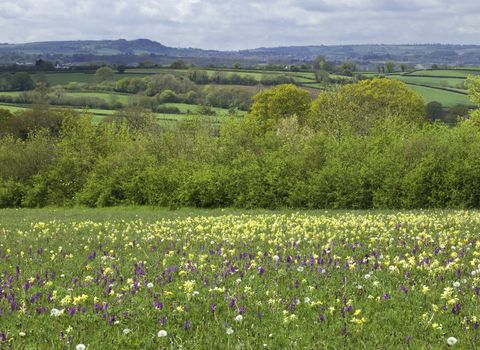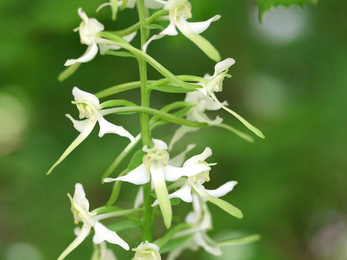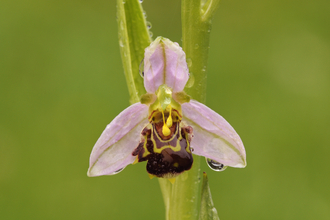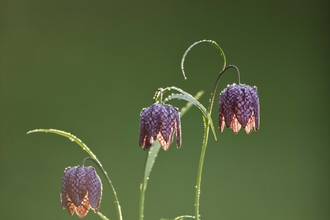Orchids
Orchids are the superstars of the wild flower world. This summer, search for the masters of mimicry cleverly fooling their pollinators, including the furry-flowered bee orchid, or its more understated cousin, the fly orchid. Sample the perfume of a fragrant orchid, or the stink of a lizard orchid. Deep in the woods, look for the bizarre bird’s-nest orchid growing in leaf litter; a parasite that steals its nutrients from the roots of trees, and has dispensed with the green chlorophyll that other plants use to make their food in favour of a creamy-brown colour all over.
Enter a bewitching world of men and monkeys, ladies and lizards, frogs and flies
Find orchids near you
You can see orchids throughout the UK, flowering between April and September, hitting peak flowering season from May. Tempting as it may be, don’t pick the flowers. Orchids look their best out in the wild, and some species are legally protected so you could be breaking the law.
Our tip pick is Hartslock in Oxfordshire; a beautiful sloping chalk grassland overlooking the Thames. Renowned for its hundreds of monkey orchids, lady orchid, and very unusually the hybrid between the two, other orchids found here include bee, pyramidal, common spotted orchids, common twayblade, and white helleborine. Red kites soar overhead and chalkhill and Adonis blues add a splash of colour later in the summer.
North
- Cumbria, Waitby Greenriggs
- Cumbria, Latterbarrow
- Durham, Blackhall Rocks
- Durham, Bishop Middleham Quarry
- Isle of Man, Close Sartfield
- Lancashire, Mere Sands Wood
- Lancashire, Salthill Quarry
- Northumberland, East Chevington Reserve
- Sheffield, Carr House Meadows
- Tees Valley, Coatham Marsh
- Yorkshire, Wharram Quarry
- Yorkshire, Brae Pasture
- Yorkshire, Denaby Ings
Midlands
- Derbyshire, The Wye Valley Reserves (Priestcliffe Lees, Chee Dale, Miller's Dale)
- Derbyshire, Rose End Meadows
- Leicestershire, Cribb’s Meadow
- Lincolnshire, Whisby Nature Park
- Nottinghamshire, Wilwell Farm Cutting
- Shropshire, Llynclys Common
- Staffordshire, Thorswood Reserve
- Warwickshire, Brandon Marsh
- Warwickshire, Draycote Meadows
- Warwickshire, Tasker's Meadow
- Warwickshire, Ufton Fields
South
- Berkshire, Greenham and Crookham Commons
- Buckinghamshire, Aston Clinton Ragpits
- Cornwall, Chyverton
- Devon, Dunsdon
- Dorset, Fontmell Down
- Gloucestershire, Elliott (Swifts Hill)
- Hampshire, Noar Hill
- Herefordshire, Stockings Meadow
- Kent, Yocklett’s Bank, Downe Bank, Park Gate Down
- London, Hutchinson’s Bank, Chapel Bank and Threecorner Grove
- Oxfordshire, Hartslock (renowned for its monkey orchids - found in only 3 places in the country!), Warburg Nature Reserve
- Surrey, Howell Hill
- Wiltshire, Lower Moor Farm (including Clattinger Farm)
- Wiltshire, Morgan's Hill
East
- Bedfordshire, Totternhoe
- Cambridgeshire, Chettisham Meadow
- Essex, Chafford Gorges Nature Park
- Essex, Thameside Nature Discovery Park
- Essex, Langdon Nature Discovery Park
- Hertfordshire, Frogmore Meadow
- Hertfordshire, Blagrove Common
- Suffolk, Martins' Meadows
- Suffolk, Winks Meadow
Wales
- Brecknock, Cae Bryntywarch
- Bridgend, Parc Slip
- Gwynedd, Caeau Tan y Bwlch
- Gwent, Pentwyn Farm
- Gwent, New Grove Meadows
- Montgomeryshire, Llanymynech Rocks
Scotland
- Ayrshire, Feoch Meadows
- Easter Ross, Talich Wildlife Reserve
Northern Ireland
- Antrim, Slievenacloy
- Armagh, Milford Cutting
Islands
- Alderney, Longis Nature Reserve
- Isles of Scilly, Autumn lady’s tresses all over the Islands and and Southern Marsh Orchids on the Higher Moors and Lower Moors
- Isle of Man, Close Sartfield
What to look for
The key to finding orchids is to do your research beforehand: target the right habitats at the right times of year. There are many sources of information: start with your local Wildlife Trust.
On chalk grassland, look for the dense pink flower spikes of pyramidal orchids and the taller, cylindrical spikes of fragrant orchid, which smell sweetly, especially in the evenings. Less ‘fragrant’ and more ‘smelly’ is the lizard orchid. A rarity found at just a few sites in the south of England, this giant among orchids has a spike of gorgeously twisty, spiral-lipped ‘lizard’ flowers, and smells strongly of goats. Be very careful where you tread: as well as the obvious flower spikes there will be plenty of non-flowering leaf rosettes which you should avoid trampling.
If you can't get to these places
Of the fifty or so species native to the UK, some are surprisingly common and widespread, while others are sought after rarities found only in a few select places. The key to finding orchids is to do your research beforehand: target the right habitats at the right times of year. There are many sources of information: start with your local Wildlife Trust.
More wildlife experiences
From seeing colourful wildflowers to spotting magnificent birds of prey, we can help you get closer to wildlife across the UK.








